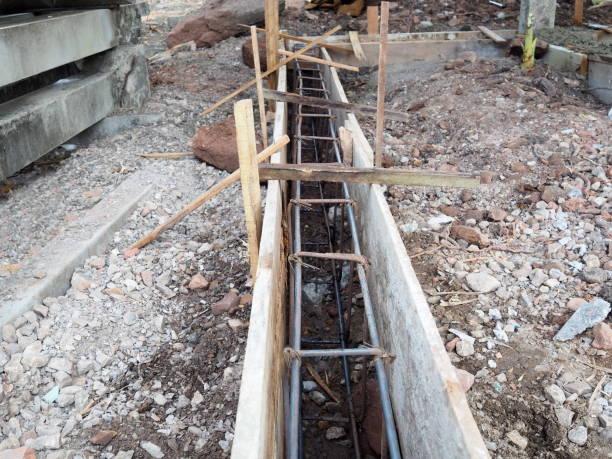Ground Beam vs Traditional Footing: Which Foundation Suits Your Project?

Choosing the right foundation method is one of the most critical decisions in any construction project. Whether you are building a small home, a commercial structure, or renovating a site, the type of footing you select can affect both the stability and the cost of your project. Ground beams and traditional footings are two widely used methods, each with its own set of benefits and limitations. Understanding their differences will help you determine the best approach based on your project’s needs, soil conditions, and budget.
What Is a Ground Beam?
A ground beam is a reinforced concrete beam constructed at ground level that spans between support points like piles or columns. Unlike traditional footings that are placed directly under walls, ground beams transfer the structural load across a wider area. They are especially useful when the ground below has uneven strength or when excavation is limited due to space or cost constraints.
This method is increasingly used in modern construction projects, particularly when dealing with poor soil conditions or in areas prone to ground movement. Ground beams can also be precast or cast in-situ, depending on the project’s scale and complexity.
Understanding Traditional Footings
Traditional footings, also known as strip or trench footings, involve digging trenches below the ground level and filling them with concrete to support load-bearing walls. This method has been used for decades and remains a standard in residential construction. The size and depth of the trench depend on the building's size, soil conditions, and local regulations.
Strip footings are straightforward and cost-effective, especially when the soil is stable and the building load is relatively light. They do, however, require significant excavation work and can be labor-intensive, which may not be ideal for every site.
Key Differences in Structural Behavior
One of the most significant differences between ground beams and traditional footings is how they handle load distribution. Ground beams spread the load laterally across support points such as piles, making them suitable for unstable or weak soils. In contrast, traditional footings rely on the strength of the soil directly beneath the trench, which means they are more vulnerable to ground shifts or poor soil quality.
Another difference is flexibility. Ground beams can bridge over areas where digging is not possible, such as underground services or soft spots in the soil. Traditional footings, on the other hand, must be continuous and dug into the ground, which limits design adaptability.
Construction Time and Cost Considerations
Cost is always a deciding factor in construction. Traditional footings are often cheaper in terms of materials, especially when working with stable soil and smaller buildings. However, they can become expensive if the ground conditions require deeper trenches or if water management becomes an issue.
Ground beams may have a higher upfront cost due to the need for reinforcement and additional engineering. But they save time and labor by reducing the amount of excavation required. This makes them cost-efficient for larger or more complex projects, especially when access is limited or rapid installation is needed.
Suitability Based on Soil Conditions
Ground conditions play a vital role in choosing the right foundation type. Traditional footings perform best in firm, undisturbed soil that can support vertical loads effectively. If the site has sandy, clayey, or backfilled soil, traditional footings may not offer sufficient stability and could lead to settlement or cracking.
In such cases, ground beams provide a practical solution. They work in combination with pile foundations, allowing the load to be transferred deep below the weak surface layer to a more stable strata. This makes ground beams a preferred option in areas with variable or poor soil quality.
Impact on Design and Architecture
Architectural requirements also influence the choice between ground beams and traditional footings. When designing buildings with basements, irregular layouts, or large open spaces, flexibility in the foundation design is essential. Ground beams allow architects and engineers to work around design challenges more effectively than conventional footings.
Additionally, ground beams are commonly used in areas where minimal disturbance to the ground is needed. This includes projects near existing structures, roads, or utility lines. Their adaptability ensures that the design intent is preserved without compromising the foundation’s strength.
Durability and Long-Term Maintenance
When installed correctly, both ground beams and traditional footings offer excellent durability. However, ground beams have a slight edge in long-term performance when used on problematic ground. Since they are usually supported by deep foundations like piles, they remain unaffected by surface changes such as erosion or frost heave.
Traditional footings may require more frequent inspection in the long term, particularly if the ground conditions change due to water ingress, tree roots, or construction nearby. Any shift in the soil can compromise the footing’s performance, which might lead to costly repairs.
Role in Residential Projects
In the context of home building, especially in modern suburbs, ground beam construction support for residential foundations is becoming more common. Developers opt for ground beams when building on reclaimed land, sloped sites, or locations with underground utilities. This method offers consistent performance and aligns well with prefabricated construction trends.
Traditional footings are still widely used in residential settings, especially for smaller, single-story homes on stable ground. Builders prefer them due to their simplicity and lower material cost. Yet, the growing complexity of urban development is slowly shifting preferences toward ground beams for added reliability and reduced site work.
Environmental and Site Access Factors
Environmental concerns and access issues can also determine which foundation system is more appropriate. Ground beams require less excavation, reducing soil displacement and the need for extensive machinery. This results in lower emissions, less disruption to the environment, and quicker site cleanup.
Traditional footings, with their need for large trench excavations, often result in more waste and a longer project timeline. They may not be suitable for environmentally sensitive areas or locations with tight access where large equipment cannot operate efficiently.
Making the Right Choice
There is no one-size-fits-all answer when comparing ground beams with traditional footings. Each project has its own set of requirements and challenges. The ideal choice will depend on several factors including soil condition, project size, budget, design flexibility, and long-term performance goals.
For projects involving unstable ground or requiring architectural flexibility, ground beams offer a modern and reliable foundation option. They provide enhanced load distribution and adaptability in design without compromising structural integrity. On the other hand, for straightforward builds on firm ground, traditional footings remain a practical and economical choice.
Conclusion
Selecting the right foundation is a foundational step toward ensuring the success of your construction project. Understanding the unique advantages and limitations of ground beams versus traditional footings can help you make an informed decision that aligns with your project goals. Whether you're a homeowner, builder, or developer, factoring in soil conditions, site constraints, and long-term performance will guide you toward the most suitable foundation system for your structure.







